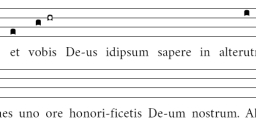I need help with psalm tone.
-
Does anybody have a minute to write in gabc format or Caeciliae some propers in the second psalmic tone? Unfortunately I don't have musical education background and it's to hard for me.
I need:
1.
Alleluia, alleluia. Lauda, lerusalem, Dominum: lauda Deum tuum, Sion. Alleluia. V. Qui posuit fines tuos pacem, et adipe frumenti satiat te. Alleluia.
2.
Det vobis Deus idipsum sapere in alterutrum: ut unanimes uno ore honorificetis Deum nostrum. Alleluia.
3.
Unus panis, et unum corpus multi sumus, omnes, qui de uno pane et de uno calice participamus. Alleluia.
-
I tried.

-
Some suggestions, notated in gabc:
I would change the "Alleluia" to: Al(g)le(e)lu(f.)ia.(f.) or Al(g)le(e)lu(ef)ia.(f.)
The start of Det vobis should be: Det(e) vo(f)bis(h)
From an typesetter's point of view: the punctus cavum (open note) should not be used as a breve note in Gregorian notation; just write out the entire reciting tone. -
I usually write out three notes in a row to indicate that it is the reciting note, and would include it for the first syllable of Alleluia, since there may be confusion without it.
-
@InNomine, judging by the breaks in the staff lines, I assume this was done with something other than Gregorio. But if you have a draft gabc file (a partial one is OK), post it, and that will give people an opportunity to suggest improvements.
-
gabc:
Offertoriumuser-notes: ;
commentary: ;
annotation: ;
centering-scheme: english;
%spacing: vichi;
%font: Crimson;
%width: 4.5;
%height: 11;
%%
(f3)Det(e) vo(g)bis(hr) De()us() i()dip()sum() sa()pe()re() in() al( )te( )ru(i )trum:(h. :) ut(hr) u()na()ni()mes() u()no() o()re() ho()no()ri()fi()ce()tis() De()um() nos()trum.() Al( )le( g)lu(e )ia.(f. ::)
Communiouser-notes: ;
commentary: ;
annotation: ;
centering-scheme: english;
%spacing: vichi;
%font: OFLSortsMillGoudy;
%width: 4.5;
%height: 11;
%%
(f3)U(e)nus(f) pa(hr)nis,() et() u()num() cor()pus() mul()ti() su(i )mus,(h. :) om(hr)nes,() qui() de() u()no() pa()ne() et() de() u()no() ca()li()ce() par()ti()ci()pa()mus.() Al( )le( g)lu( e )ia.(f. ::) -
It's easy to make improvements here.
First, remove any spaces within parentheses ().
Then, separate any colons (for barlines) from the preceding word. The last word in the piece therefore becomesAl()le(g)lu(e)ia.(.) (::)
Notice the space before "(::)"; keep that.
Also, I recommend the centering scheme "latin" instead of "english". This will center each neume above the corresponding vowel, as is customary, instead of over the syllable.
So the first gabc file becomes this:
user-notes: ;
commentary: ;
annotation: ;
centering-scheme: latin;
%spacing: vichi;
%font: Crimson;
%width: 4.5;
%height: 11;
%%
(f3)Det(e) vo(g)bis(hr) De()us() i()dip()sum() sa()pe()re() in() al()te()ru(i)trum:(h.) (:) ut(hr) u()na()ni()mes() u()no() o()re() ho()no()ri()fi()ce()tis() De()um() nos()trum.() Al()le(g)lu(e)ia.(f.) (::)
That produces a fairly neat score; see below. This is almost ready.
If you just add an explicit reciting note on the first syllable of "unanimes", that will help clarify things, and it will fix the misleading custos at the end of line 1.
 snapshot81.png749 x 253 - 5K
snapshot81.png749 x 253 - 5K -
Thank you for you previous support !
Now I'm preparing Sunday Compline in gabc and I have a problem with dashes in text.
Original:
Gabc:
Code:name: Psalmus 90;
office-part: Psalmus;
book: Liber Usualis, 1961, p. 265;
transcriber: InNomine;
initial-style: 0;
centering-scheme: latin;
%%
(c4)1. ( )Qui(g) há(h)bi(j)tat(j) in(j) a(j)di()u(j)tó(j)ri(j)o(j) Al(j)tís(k)si(jr)mi,(j.)*(:) in(j) pro(j)tec(j)ti(j)ó(j)ne(j) Dé(j)i(j) ca()é(j)li(j) com(i)mo(j)rá(h)bi(gr)tur.(g.) (::)
How to insert dashes in the same way as they are in Liber usualis? -
"ae" in "caeli" is a diphthong that in church Latin is pronounced like "e." The two letters should not be separated by a dash or sung to two notes.
I have no experience with the software you are trying to use, but it appears to me that writing these verses out with the Meinrad fonts would be almost effortless. Have you tried them? -
One may enter hyphens explicitly, after the syllable and before the neume. Please also note the curly brackets at the beginning of the verse, which tell Gregorio over which letter to place the neume.name: Psalmus 90;
office-part: Psalmus;
book: Liber Usualis, 1961, p. 265;
transcriber: InNomine;
initial-style: 0;
centering-scheme: latin;
%%
(c4)1. Qu{i}(g) há(h)bi(j)tat(j) in(j) a(j)diu(j)tó(j)ri(j)o(j) Al(j)tís(k)si(jr)mi,(j.) *(:) in(j) pro(j)tec(j)ti(j)ó(j)ne(j) Dé(j)i(j) caé(j)li(j) com(i)mo(j)rá(h)bi-(gr)tur.(g.) (::)
Also be mindful that other layout issues (e.g., font face and style) will determine how Gregorio places hyphens.Thanked by 1Ben -
I looks like the spacing is too wide. With the Illuminare Score Editor (an online tool to typeset gabc) it's possible to adjust the spacing from tight ('Vichi') to wider ('default').
That said, it's not really important that your engraving should be exactly identical to the one found in the Liber Usualis. The text and the notes should be there, and the entire engraving should be pleasing to the eye, that's all. Gregorio will create hyphens when it's needed. This depends on the spacing and the font.Thanked by 1SkirpR
Welcome to the MusicaSacra Forum!
To participate in the discussions on Catholic church music, sign in or register as a forum member, The forum is a project of the Church Music Association of America.
Categories
- All Discussions21,164
- General Music Discussion8,241
- Job Openings204
- Management of Music Programs850
- Choral Matters533
- Church Documents and Rubrics526
- CMAA Notes304
- Events720
- For Newcomers: Read First26
- Sacred Polyphony547
- Hymnody872
- Gregorian Chant: General2,703
- ↳ Graduale Romanum and Liber Usualis369
- ↳ Graduale Simplex60
- ↳ Semiology63
- Vernacular Plainsong696
- Anglican Use and Anglican Chant68
- Organ, Other Instruments and Repertoire435
- New Composition/Works in Progress1,295
- Recordings234
- Music for Hispanic Ministry159
- Music Education: Children211
- Music Education: General222
- News Items245
- Positions Wanted2
- General Discussion: Catholicism740
- Amusements177
- General Discussion1,035
- Opinions119




